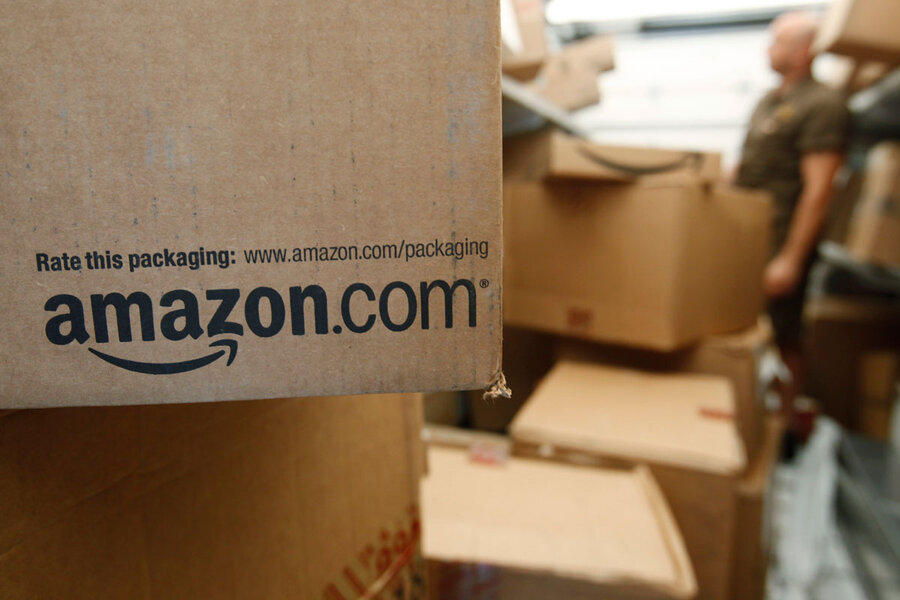Is Amazon's exclusive Prime credit card a good deal?
Loading...
The online retail giant Amazon is rolling out another product to lure its loyal customers. This time, it’s a credit card with appealing terms.
The search company collaborated with JP Morgan Chase for the new Amazon Prime Rewards Visa Signature Card, announced on Wednesday. The new card rewards its cardmembers as much as five percent on any purchase from the website, according to a press release from the company – while, for Amazon and Chase, it represents one more way to capitalize on the website's massive customer base.
The idea of the card, which targets Amazon Prime members, is not brand new. It is built upon the existing Amazon Rewards Visa Signature card, which currently offers a three-percent reward. Cardholders who are also Prime members will be automatically upgraded, according to Amazon.
“What's new is accelerating and improving the rewards process to make it a more enticing proposition to cardholders,” David Robertson, publisher of the Nilson Report, a trade publication on credit card industry, tells The Christian Science Monitor. “And that's really where the game is these days and for the last two years or more…And there's a real battle to try to become first or top in wallet.”
In addition to five percent back on all purchases from Amazon’s website, the card offers a two-percent cash reward at restaurants, gas stations, and drugstores, and one percent everywhere else. It does not charge an annual fee or a foreign transaction fee; to be eligible, however, customers must pay $99 per year to join the company’s Prime membership.
“We are adding even more value to Prime by offering rewards on Amazon and everywhere else you shop,” Max Bardon, a vice president at Amazon, said in a statement.
Zack Friedman, founder of Make Lemonade, a finance platform that offers financial advice, said this card is Amazon’s strategy to increase its Prime membership.
“Clearly, Amazon wants to increase its Prime membership base, which has been a major profitability and growth engine for Amazon …and an effective strategy to retain its customer base,” he wrote in a piece on Forbes.
Created in 2005 as a way to offer free two-day shipping, an Amazon Prime membership now includes streaming music, TV shows, and movies, among other benefits.
“It’s interesting for Amazon in that they keep layering on more and more things to make that Prime membership more and more attractive,” Matt Schulz, a senior industry analyst at Creditcards.com, tells the Monitor. “It’s interesting to see how they’ve expanded that to grow the loyalty.”
Mr. Robertson says offering credit is also Amazon’s way to generate additional profits from its existing customer base.
“At some point, you get to the top end of what your potential customer base is, and then what you have to do is to mine your existing customer base for additional profits, and that's where revolving credit cards come in,” he says.
According to Consumer Intelligence Research Partners, nearly half of households had a Prime membership in early 2016, reaching 54 million – a customer base that represents potential for Chase, as well.
“Hundreds of millions of people shop at Amazon.com and there is no better way to earn rewards for their purchases than Chase’s new Amazon Prime Rewards Visa Signature Card,” Kevin Watters, the chief executive of Chase card services, said in a statement. “We are thrilled to be working with Amazon to offer even more value to our cardmembers.”
Analysts say this newly designed metal card could be Chase’s way to replicate the early success of its popular Sapphire Reserve card.
“This is another example of Chase going all out to attract high-end credit card customers,” Mr. Schulz says. “Even though the Amazon Prime customer isn’t a monolithic thing, and there's an awful lot of people in that group, it would stand to reason that the average Amazon Prime member is probably a little more upscale than the typical Amazon customers.”
Some observers warn against the potential impact Amazon’s new credit card might have on brick-and-mortar businesses.
“The Amazon Prime Rewards Signature Visa Card is a potential disruptor that can change the retail landscape,” Mr. Friedman tells the Monitor in an email. "By expanding its credit card benefits, Amazon’s strategy is for consumers to make Amazon their default retailer for virtually all their shopping needs."
Yet, while Amazon might attempt to grab more market share through this card, Robertson says, “this will not set the world on fire. This is an add-on.”








